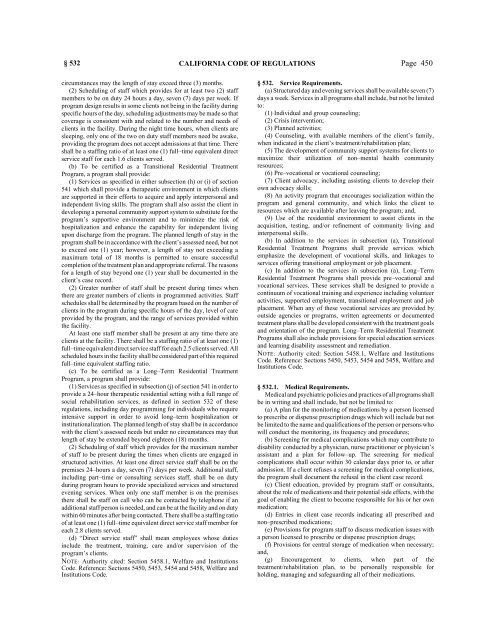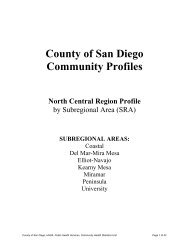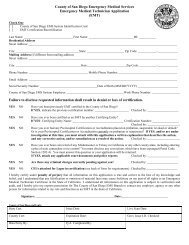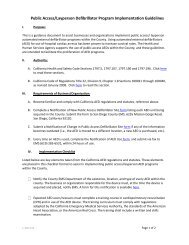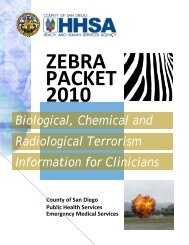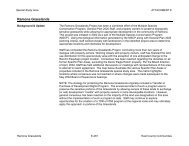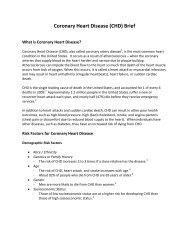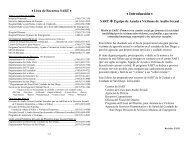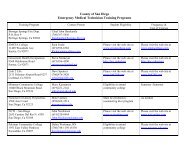CALIFORNIA CODE OF REGULATIONS - State of California
CALIFORNIA CODE OF REGULATIONS - State of California
CALIFORNIA CODE OF REGULATIONS - State of California
You also want an ePaper? Increase the reach of your titles
YUMPU automatically turns print PDFs into web optimized ePapers that Google loves.
§ 532 <strong>CALIFORNIA</strong> <strong>CODE</strong> <strong>OF</strong> <strong>REGULATIONS</strong><br />
Page 450<br />
circumstances may the length <strong>of</strong> stay exceed three (3) months.<br />
(2) Scheduling <strong>of</strong> staff which provides for at least two (2) staff<br />
members to be on duty 24 hours a day, seven (7) days per week. If<br />
program design results in some clients not being in the facility during<br />
specific hours <strong>of</strong> the day, scheduling adjustments may be made so that<br />
coverage is consistent with and related to the number and needs <strong>of</strong><br />
clients in the facility. During the night time hours, when clients are<br />
sleeping, only one <strong>of</strong> the two on duty staff members need be awake,<br />
providing the program does not accept admissions at that time. There<br />
shall be a staffing ratio <strong>of</strong> at least one (1) full–time equivalent direct<br />
service staff for each 1.6 clients served.<br />
(b) To be certified as a Transitional Residential Treatment<br />
Program, a program shall provide:<br />
(1) Services as specified in either subsection (h) or (i) <strong>of</strong> section<br />
541 which shall provide a therapeutic environment in which clients<br />
are supported in their efforts to acquire and apply interpersonal and<br />
independent living skills. The program shall also assist the client in<br />
developing a personal community support system to substitute for the<br />
program’s supportive environment and to minimize the risk <strong>of</strong><br />
hospitalization and enhance the capability for independent living<br />
upon discharge from the program. The planned length <strong>of</strong> stay in the<br />
program shall be in accordance with the client’s assessed need, but not<br />
to exceed one (1) year; however, a length <strong>of</strong> stay not exceeding a<br />
maximum total <strong>of</strong> 18 months is permitted to ensure successful<br />
completion <strong>of</strong> the treatment plan and appropriate referral. The reasons<br />
for a length <strong>of</strong> stay beyond one (1) year shall be documented in the<br />
client’s case record.<br />
(2) Greater number <strong>of</strong> staff shall be present during times when<br />
there are greater numbers <strong>of</strong> clients in programmed activities. Staff<br />
schedules shall be determined by the program based on the number <strong>of</strong><br />
clients in the program during specific hours <strong>of</strong> the day, level <strong>of</strong> care<br />
provided by the program, and the range <strong>of</strong> services provided within<br />
the facility.<br />
At least one staff member shall be present at any time there are<br />
clients at the facility. There shall be a staffing ratio <strong>of</strong> at least one (1)<br />
full–time equivalent direct service staff for each 2.5 clients served. All<br />
scheduled hours in the facility shall be considered part <strong>of</strong> this required<br />
full–time equivalent staffing ratio.<br />
(c) To be certified as a Long–Term Residential Treatment<br />
Program, a program shall provide:<br />
(1) Services as specified in subsection (j) <strong>of</strong> section 541 in order to<br />
provide a 24–hour therapeutic residential setting with a full range <strong>of</strong><br />
social rehabilitation services, as defined in section 532 <strong>of</strong> these<br />
regulations, including day programming for individuals who require<br />
intensive support in order to avoid long–term hospitalization or<br />
institutionalization. The planned length <strong>of</strong> stay shall be in accordance<br />
with the client’s assessed needs but under no circumstances may that<br />
length <strong>of</strong> stay be extended beyond eighteen (18) months.<br />
(2) Scheduling <strong>of</strong> staff which provides for the maximum number<br />
<strong>of</strong> staff to be present during the times when clients are engaged in<br />
structured activities. At least one direct service staff shall be on the<br />
premises 24–hours a day, seven (7) days per week. Additional staff,<br />
including part–time or consulting services staff, shall be on duty<br />
during program hours to provide specialized services and structured<br />
evening services. When only one staff member is on the premises<br />
there shall be staff on call who can be contacted by telephone if an<br />
additional staff person is needed, and can be at the facility and on duty<br />
within 60 minutes after being contacted. There shall be a staffing ratio<br />
<strong>of</strong> at least one (1) full–time equivalent direct service staff member for<br />
each 2.8 clients served.<br />
(d) “Direct service staff” shall mean employees whose duties<br />
include the treatment, training, care and/or supervision <strong>of</strong> the<br />
program’s clients.<br />
NOTE: Authority cited: Section 5458.1, Welfare and Institutions<br />
Code. Reference: Sections 5450, 5453, 5454 and 5458, Welfare and<br />
Institutions Code.<br />
§ 532. Service Requirements.<br />
(a) Structured day and evening services shall be available seven (7)<br />
days a week. Services in all programs shall include, but not be limited<br />
to:<br />
(1) Individual and group counseling;<br />
(2) Crisis intervention;<br />
(3) Planned activities;<br />
(4) Counseling, with available members <strong>of</strong> the client’s family,<br />
when indicated in the client’s treatment/rehabilitation plan;<br />
(5) The development <strong>of</strong> community support systems for clients to<br />
maximize their utilization <strong>of</strong> non–mental health community<br />
resources;<br />
(6) Pre–vocational or vocational counseling;<br />
(7) Client advocacy, including assisting clients to develop their<br />
own advocacy skills;<br />
(8) An activity program that encourages socialization within the<br />
program and general community, and which links the client to<br />
resources which are available after leaving the program; and,<br />
(9) Use <strong>of</strong> the residential environment to assist clients in the<br />
acquisition, testing, and/or refinement <strong>of</strong> community living and<br />
interpersonal skills.<br />
(b) In addition to the services in subsection (a), Transitional<br />
Residential Treatment Programs shall provide services which<br />
emphasize the development <strong>of</strong> vocational skills, and linkages to<br />
services <strong>of</strong>fering transitional employment or job placement.<br />
(c) In addition to the services in subsection (a), Long–Term<br />
Residential Treatment Programs shall provide pre–vocational and<br />
vocational services. These services shall be designed to provide a<br />
continuum <strong>of</strong> vocational training and experience including volunteer<br />
activities, supported employment, transitional employment and job<br />
placement. When any <strong>of</strong> these vocational services are provided by<br />
outside agencies or programs, written agreements or documented<br />
treatment plans shall be developed consistent with the treatment goals<br />
and orientation <strong>of</strong> the program. Long–Term Residential Treatment<br />
Programs shall also include provisions for special education services<br />
and learning disability assessment and remediation.<br />
NOTE: Authority cited: Section 5458.1, Welfare and Institutions<br />
Code. Reference: Sections 5450, 5453, 5454 and 5458, Welfare and<br />
Institutions Code.<br />
§ 532.1. Medical Requirements.<br />
Medical and psychiatric policies and practices <strong>of</strong> all programs shall<br />
be in writing and shall include, but not be limited to:<br />
(a) A plan for the monitoring <strong>of</strong> medications by a person licensed<br />
to prescribe or dispense prescription drugs which will include but not<br />
be limited to the name and qualifications <strong>of</strong> the person or persons who<br />
will conduct the monitoring, its frequency and procedures;<br />
(b) Screening for medical complications which may contribute to<br />
disability conducted by a physician, nurse practitioner or physician’s<br />
assistant and a plan for follow–up. The screening for medical<br />
complications shall occur within 30 calendar days prior to, or after<br />
admission. If a client refuses a screening for medical complications,<br />
the program shall document the refusal in the client case record.<br />
(c) Client education, provided by program staff or consultants,<br />
about the role <strong>of</strong> medications and their potential side effects, with the<br />
goal <strong>of</strong> enabling the client to become responsible for his or her own<br />
medication;<br />
(d) Entries in client case records indicating all prescribed and<br />
non–prescribed medications;<br />
(e) Provisions for program staff to discuss medication issues with<br />
a person licensed to prescribe or dispense prescription drugs;<br />
(f) Provisions for central storage <strong>of</strong> medication when necessary;<br />
and,<br />
(g) Encouragement to clients, when part <strong>of</strong> the<br />
treatment/rehabilitation plan, to be personally responsible for<br />
holding, managing and safeguarding all <strong>of</strong> their medications.


